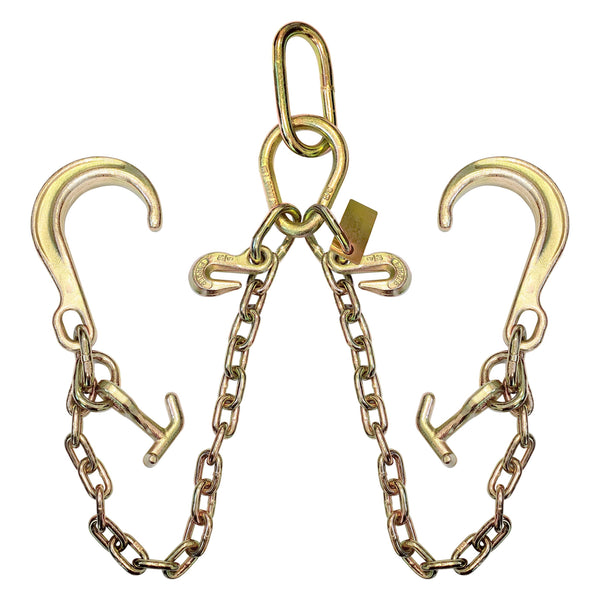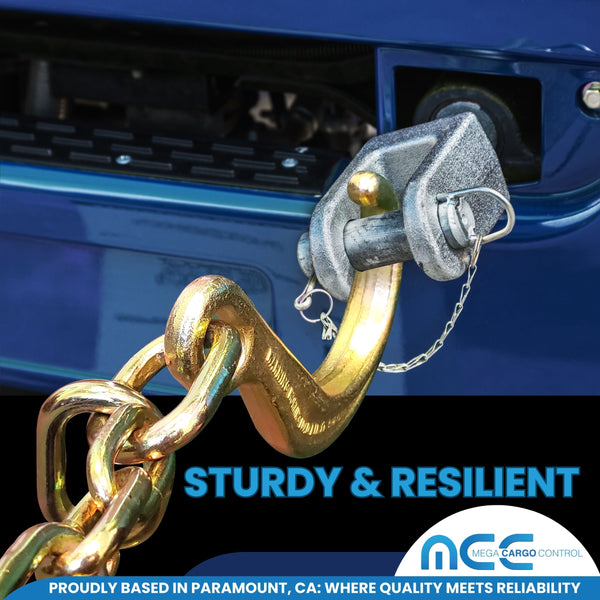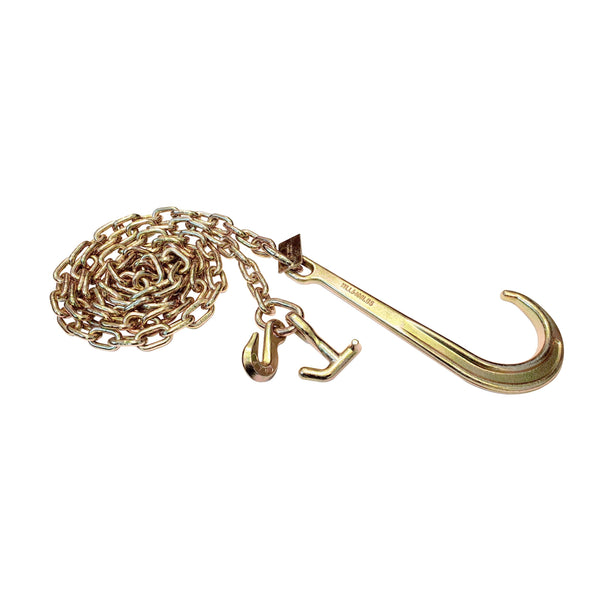When it comes to heavy-duty towing, recovery, and load stabilization, few tools are as essential—or as misunderstood—as the bridle chain. Also known as a V-chain, Y-chain, or double-leg chain, this specialized rigging solution provides superior weight distribution, reduced strain, and unmatched versatility compared to standard tow chains.
What Is a Bridle Chain? (And Other Names for It)
A bridle chain is a short-length towing chain with a V-shaped (or Y-shaped) configuration, splitting into two legs with hooks at the ends. This design allows for balanced force distribution when securing or towing loads.

What Is a Bridle Chain? (And Other Names for It)
A bridle chain is a short-length towing chain with a V-shaped (or Y-shaped) configuration, splitting into two legs with hooks at the ends. This design allows for balanced force distribution when securing or towing loads.
Other Common Names for Bridle Chains:
- ✔ V-chain (due to its shape)
- ✔ Y-chain (when the split resembles a "Y")
- ✔ Double-leg chain (referring to its two attachment points)
- ✔ Recovery bridle (common in off-road & towing industries)
Key Components of a Bridle Chain:
- ✔ Grade 70 high-strength steel (4,700 lb WLL)
- ✔ Two separate legs (typically 2 FT each)
- ✔ Heavy-duty hooks (J-hooks, grab hooks, or combo hooks)
Industries That Rely on Bridle Chains
🚛 Towing & Recovery
- ✔ Vehicle recovery operations (balanced pull prevents rollovers)
- ✔ Flatbed trucking (secures unstable loads)
🏗️ Construction & Heavy Equipment
- ✔ Moving excavators, bulldozers, and cranes
- ✔ Stabilizing loads on lowboy trailers
🌾 Agriculture & Farming
- ✔ Towing tractors and combines
- ✔ Securing hay balers and other implements
🚙 Off-Road & Overlanding
✔ Jeep and truck recoveries
✔ Rock crawling and mudding situations

Why Use a Bridle Chain? Key Benefits & Applications
1. Even Weight Distribution
Unlike a single-leg chain, a bridle chain spreads tension across two anchor points, reducing stress on the tow vehicle and preventing load shifting.
Why Use a Bridle Chain? Key Benefits & Applications
1. Even Weight Distribution
Unlike a single-leg chain, a bridle chain spreads tension across two anchor points, reducing stress on the tow vehicle and preventing load shifting.
2. Improved Stability
The V-shape minimizes sideways pull, making it ideal for recovering stuck vehicles or securing unstable loads.
3. Reduced Chain Wear
By eliminating single-point stress, bridle chains experience less stretching and damage over time.
4. Versatile Attachments
With dual hooks, you can secure to:
✔ Axles
✔ Frame points
✔ D-rings
✔ Recovery shackles
Need a Longer Chain? Check Out Our 10 FT Transport Tow Chain!
While bridle chains excel in short-distance, high-stability applications, our 10 FT Transport Tow Chain is the go-to choice for longer reaches and adjustable towing.

Need a Longer Chain? Check Out Our 10 FT Transport Tow Chain!
While bridle chains excel in short-distance, high-stability applications, our 10 FT Transport Tow Chain is the go-to choice for longer reaches and adjustable towing.
Glossary of Towing Terms
| Term | Definition |
|---|---|
| 1. Bridle Chain | A V-shaped or Y-shaped towing chain with two legs, designed to distribute pulling force evenly across two anchor points. Commonly used in recovery operations to prevent vehicle damage. |
| 2. Grade 70 Chain | A high-strength steel chain with a 4,700 lb Working Load Limit (WLL), identifiable by its bright yellow markings. The DOT standard for transport and recovery chains. |
| 3. Grab Hook | A heavy-duty hook that latches onto chain links, allowing for quick length adjustments when securing loads. Essential for fine-tuning tension in towing setups. |
| 4. J-Hook | A curved, J-shaped hook used to attach chains to axles, frames, or D-rings. Often has a long shank for reaching difficult anchor points. |
| 5. Shank | The straight, elongated section of a hook (like a J-hook) that provides extra reach for securing to deep-set anchor points on vehicles or equipment. |
| 6. Working Load Limit (WLL) | The maximum safe weight a chain or hook can handle under normal conditions. Never exceed the WLL—doing so risks equipment failure. |
| 7. V-Chain (V-Bridle) | Another name for a bridle chain, referring to its V-shaped design that splits into two legs for balanced towing force distribution. |
| 8. Y-Chain | A variation of a bridle chain where the split resembles a "Y" shape instead of a sharp "V." Functions similarly for dual-point recovery. |
| 9. Master Pear Ring (O-Link) | The central anchor point on a bridle chain where the two legs meet. Used to connect to winches, tow cables, or recovery straps. |
| 10. Recovery Strap | A flexible nylon or polyester strap used for kinetic energy recoveries (like snatch straps). Unlike chains, straps stretch to absorb shock. |
| 11. Towing Chain | A heavy-duty chain (usually Grade 70) designed for vehicle recovery, hauling, and load securing. More durable than straps but less flexible. |
| 12. RTJ-Chain Assembly | A single-leg chain with multiple hooks (J-hooks, T-hooks, or grab hooks) at the end. Used for versatile attachment options on frames or axles. |
| 13. V-Strap Assembly | A lightweight alternative to V-chains, using polyester webbing legs instead of metal. Prevents scratches but has a lower WLL than chains. |
| 14. Auto-Hauling Chain | A single-leg, heavy-duty chain with a reinforced hook (often a J-hook or combo hook). Designed for flatbed towing and transport. |
| 15. Combo Hook (TJ Hook) | A hybrid hook combining a grab hook and slip hook, allowing for multiple attachment styles in one tool. |
| 16. D-Ring | A D-shaped metal ring welded onto vehicles or trailers for secure chain or strap attachment. Common on tow trucks and off-road rigs. |
| 17. Kinetic Recovery | A dynamic pulling technique using elastic straps (not chains) to "snatch" stuck vehicles out of mud/sand. Chains are not safe for this method. |
| 18. Grade 43 Chain | An older, weaker chain grade (about 20-25% less strong than Grade 70). Lacks the yellow markings of Grade 70 chains. |
| 19. Chain Shortener | A grab hook or slip hook used to reduce chain length by looping excess links. Critical for adjusting tension in towing setups. |
| 20. Corrosion Resistance | A property of galvanized or coated chains to resist rust. Essential for marine, off-road, or winter use where salt and moisture are present. |
| 21. Break Strength | The maximum force a chain can withstand before snapping. Typically 4-5x higher than the WLL (e.g., 23,500 lbs for Grade 70). |




